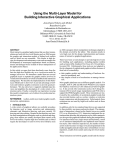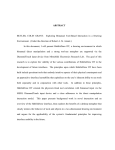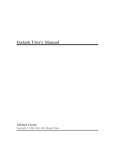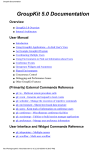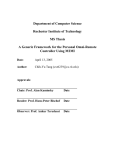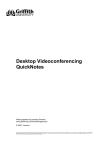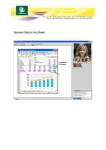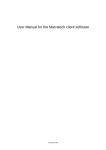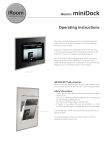Download Final paper - List of Research Wikis
Transcript
Software-based Projector Sharing Research
Myungcheol Doo and Chih-Sung Wu (Andy) Wu
College of Computing
Georgia Institute of Technology
Atlanta, GA 30332
{mcdoo, andywu}@cc.gatech.edu
ABSTRACT
RELATED WORK
In this paper we propose a way of sharing image for
supporting occasional meetings. Our main idea is that the
sharing information occurs across public displays that users
can easily access and interact with. To do this, we designed
and implemented user-friendly software.
Planex Communication's GW-AP54PR [1] is a user friendly projecting device which turns a user's project into a
wireless device so that any laptop or desktop computers can
easily send VGA signal to the projector through Wireless
and Ethernet environment. GW-AP54PR has almost similar
functions that we present here. Users can instantly project
user's screen to the projector within just one click. Also it
supports multi-users to switch user's computer screen to
projector without moving the computer to the projector and
switch a VGA cable.
Author Keywords
Sharing, Projector, Display, Ubiquitous Computing, CSCW
ACM Classification Keywords
H.5.3 Group and Organization Interfaces: Compuersupported cooperative work
INTRODUCTION
The idea of sharing information through a projector
increases efficiency of group activities. However,
sometimes switching between laptops takes a long time or
needs to be manipulated to adjust laptop's resolution. Those
things might hinder or delay ongoing conversation. Thus,
there are needs to share what the user sees on a public
display without delaying. Also, there are lots of expensive
projectors or wall displays that are idle. If we can create a
procedure that people can follow and build devices to share
information, the rate of usages will increase. Because we
believe that information sharing should be easy for a group
of users and the administration of information sharing
should be easy and large displays or projectors are
expensive, we should try to use the most of them.
Figure 1. GW-AP54PR connection example
In the previous project, we developed software that allows a
user to share his/her screen with others through a projector.
Unlike the traditional way, which is plugging/unplugging a
VGA cable, users install software and click an icon to share
their screen. We expect that this software will encourage
people to share their screen more frequently in a meeting.
In this project, we will do user test to verify our solution.
Besides Planex's device, Stanford University presented an
Interactive Room (iRoom) [2]. The iRoom contains three
touch sensitive displays along the sidewall and a display
that was designed to look like a standard conference-room
table. In the iRoom users can do move data, that is, users in
the room are able to move data among the various
visualization applications that run on screens in the room
and on laptops or PDAs that are brought into the
workspace. However, for users who want just sharing
images the iRoom project is too big to use.
The Dynamo system [3] has been designed as a large
publicly accessible interactive surface that allows people to
gather around, share, display, and exchange media with
others. The surface provides a multi cursor environment
with each interaction point being represented by a colorcoded pointer, called telepointer. Users take control of these
1
telepointers to interact with the surface. Dynamo surface is
more than sharing display. It is designed for exchange
digital media with others.
Single display groupware was developed to support
shoulder-to-shoulder collaboration on a large display with
multiple input points. Such systems allow multiple users to
simultaneously interact with shared applications. Early
examples include Cognoter [4] and MMM [5]. More
recently, the Pebbles system [6] has explored how PDAs
can provide concurrent input to a shared display. Similarly,
Kidpad [7] supports multi-mice input with a view to
promoting collaboration within the classroom.
through TCP/IP. Once it is connected and the user wants to
show her desktop image, client software captures desktop
image and sends it to the server every seconds. The server
gets image and show it on a projector.
From the HCI perspective, we devised simple user
interfaces. Once the software is launched, it is hiding in a
system tray. Users click the icon in a system tray with a
right mouse button when she wants to share her screen. The
software pops up a dialog asking the IP address of the
server computer. Once the user enters the IP address, she
can share images by just clicking the icon with a left mouse
button.
SOLUTION
We intend to build software that can send the laptop screen
to a projector connected to . We expect an application with
one-click sharing function will help users work more
efficiently using projectors.
User Scenario
Thad was teaching CS 7470 using a projector. He showed a
website to his students. But one student found another
interesting website, and he wanted to showed it to the class,
too. However, he could not show the website from his seat.
Therefore, he spoke out the address of the website to Thad
and asked Thad to show it to the class.
System Setup
We construct a prototype of sharing a projector and created
a software application for sharing images via Wireless and
Ethernet environment. Figure 2 shows how the system
architecture consists of. A projector, which stands for a
public display that users want to use for sharing images, is
connected to a server computer through a VGA cable. A
server computer will be customized in the future as a small
device so that the projector can embed.
Figure 3. This figure shows how a client-server connection
establishes. When the server is up and running, it creates a
server thread and listen to port 8888. When a client
connects to the server (1), the server creates an image
thread (2) that sends and receives the data (3) and shows
them on the screen.
Figure 2. The system architecture
Figure 4. This figure shows how a client creates connection
with the server while there’s another client connecting to
the server. A client is trying to connect to the server through
port 8888 (1). The server first kills (2) the previous client
(3). After that, it creates a new image thread (4) to
communicate with the new client.
On idle, the server shows a screen that shows an IP address
of the computer and how to connect to the server. Each
client, such as a PDA, laptop/desktop computers and mobile
devices download software and connect to the server
The software package can be divided into 2 parts, a server
running on the computer attached to the projector, and
clients running on the laptops that are going to show
screenshots to the projector. The server is a multithreaded
program that allows only one thread to receive image data
from one client at a time.
EVALUATION AND DISCUSSION
Implementation
The objective of the evaluation plan is to verify the
usability of software when sharing a projector. The user
study will be two observations followed by a questionnaire
and then a focus group interview. The flow of the study will
be:
The objective of the evaluation plan is to verify if the users
prefer to use our software when sharing a projector. Our
hypothesis is “users like this software better and this
software makes their work more efficient.”
Experiment Design
The software was implemented as a server/client structure.
For image processing we used OpenCV libraries. Both
client and server-side programs are running as a thread in
order to perform multiple tasks. Server-side program opens
a socket and waits for a connection from clients. Once a
client requests it assign a new socket to the client and
receive images and shows it on a projector. The client
program is also running as a background process and
grabbing desktop image as a JPEG file and sending it to the
server.
10 minutes
Introduction; practicing, getting familiar
with the software and hardware
20 minutes
Condition 1
5 minutes
Rest time
20 minutes
Condition 1
5 minutes
Questionnaire
20 minutes
Focus group interview
Table 1. The flow of user study.
To interpret the data afterward, we videotaped the
observation, and the focus group user study. We expected
to recruit 24 subjects and divide them into 6 groups.
When the participants arrive at the schedule time, we
introduced the study to participants in detail and ask them
to sign the consent form. After that, we give them time to
be familiar with the laptops and our software because based
on our pilot test; some people don't know how to use a
projector.
Figure 5. The welcome screen of the software shows the IP
address of the server in the middle of the image.
We design a task of finding 12 photos that are used for
creating a photo calendar. The participants have to work
collaboratively to accomplish the task. In the test,
participants are asked to find 12 photos by themselves on
websites such as google.com and flickr.com. For each
proposed photo, they have to ask other group members’
opinions. In other words, the photo has to be shown to
others. Once the other members agree with the photo then
the photo is used for the calendar.
The study is a within user test. We recruited four groups
and conducted two tests. Each group did the same job,
finding photos, twice. In one test, users show their photos
by switching a VGA cable. In the other test, they use our
software. To avoid order effects, 2 groups performed the
task using a traditional cabled projector first while the other
2 groups did the task with our software first.
Figure 6. The user can choose the server to connect to.
3
"Totally Agree" as -2 to +2. We found the average level of
agreement is 1.58 and the standard deviation is 0.42.
Therefore, we can conclude that the users like our software
better. As a result, we verify our hypothesis.
Results of observation
As to the observation, we also measure the time user spent
between she initialized the request for the VGA cable and
the time she actually showed the image on the projector
screen. The average time spent by the subjects is shown in
Figure 9. The total time they spent in the study in shown in
Table 2.
Figure 7. The control group
Using Cable
Using Software
Improvement
Team 1
17:26 (1046s)
7:25
+57.5%
Team 2
21:30 (1290s)
18:45
+12.8%
Team 3
9:40 (580s)
5:40
+41.4%
Team 4
17:42 (1062s)
20:53
-18.0%
Table 2. The total time spent in the study
Most results show that the software does improve the usage
of time. However, team 4 has a totally different result than
other teams. The reason is because subjects in team 4
shared more than one photo every time they plugged in the
cable. Therefore, they saved a lot of time using cable. We
also calculate the percentage of time used in plugging /
unplugging the cable (see Table 3). We do not calculate the
time of switching between users in the experimental group,
since the projector screen was always showing some
information and we could not know the time a user initiated
a call for sharing photos.
Showing
Image
on
projector
Figure 8. The experimental group
In Figure 7 a girl in pink shirt is passing a VGA cable to the
girl in right. So the projector doesn’t show anything in this
moment. Figure 8 shows people are showing images
without any further physical movements.
t1
/
Total
Time
Time
Spent in
plugging
Cable
(t2)
t2 / t1
(The cost
of
projecting
one
second
image)
t2
/
Total
Time
(t1)
After the two observation sessions, we gave the participants
questionnaires. Table xxx shows the questionnaires. Right
after the questionnaire, there was a focus group interview.
Team
1
8:42
(552s)
52.8%
346s
0.62s
33.1%
Results of User Study
Team
2
6:07
(367s)
28.5%
263s
0.71s
20.4%
Team
3
7:56
(476s)
82.1%
214s
0.45s
36.9%
Team
4
3:44
(224s)
21.1%
112s
0.5s
10.5%
In our pilot run, we found that GT Wireless was not stable.
Therefore, we used our own wireless router. Since there
were not enough wireless Ethernet cards, some of
participants used cable connection to the router. Also some
participants have laptop computers while others do not.
Thus we use a desktop computer in those cases.
Results of questionnaires
We finally recruited 16 subjects from Georgia Tech
campus. Half of the subjects are females. We quantized the
questionnaire results by assigning "Totally Disagree" to
Table 3. The total time of projector usage. The cost of
projecting one second image means, the time spent on
plugging cables to show a one-second image. This table
shows how much time the subjects wasted on plugging the
cable.
Average time showing screen image with cable
Some teams decided a photo for each month, and
made decision according to the weather of that
month while others just chose 12 photos.
No subjects used the “stop sharing” button. In fact,
they all ignored that button.
During the rest time, some groups kept playing the
photo sharing game using the software, but not
using the cable.
One subject forgot she was using the software and
looked for the cable.
One of the subjects kept pressing the wrong hotkey
and couldn't switch output to the projector. But she
did practice before the study began.
Subjects walked to those with problem using
cables and helped them.
Since the software delayed for 1 or 2 seconds to
show the image, one group negotiated the order of
using the software before sharing the screen.
35
30
25
20
Series1
15
10
5
0
1
2
3
4
5
6
7
8
9
10
11
12
13
14
15
16
Time (Sec)
Figure 9. The average time of plugging cable to the
projector. 3 samples are dropped because the
subjects couldn't show the image to the projector
and gave up finally.
Histogram
7
6
Words from the subjects
5
We obtained feedbacks that help us understand the subjects’
thoughts better from the focus group interviews. This is
what they said in the discussion:
4
3
2
1
I like this software a lot.
I hope the software encrypt the image before
sending out.
I want to play video using this software. (The
subject had no idea about the frame rate
limitation.)
We seldom use projectors like this way.
0
0-3
3-6
6-9
9-12
12-15
15-18
18-21
21-24
24-27
27-30
30-33
33-36
Time (sec)
Figure 10. The histogram of average time spent in using
cable connection to the projector
We also notice some interesting phenomena of user
behaviors:
I have to show everything to others, no privacy.
Subjects tried to maximize the browser window
before they showed it to the projector screen.
I don’t know who is sharing the screen now.
(Using software)
At least 10 subjects were doing other things while
the study was processing, e.g. reading emails,
news, visiting online stores, chatting on IMs...
How about showing two screens on the projected
screens?
The fish theme made subjects confused. They
didn't know that a whale is not a fish, a jellyfish is
not a fish, a sea horse is not a fish, a lobster is not
a fish, and a dolphin is not a fish.
This is good for small team discussion.
Subjects unplugged the cable immediately when
they were not using the projector.
At least 2 subjects pressed the wrong key
combination while using the cable and entered the
hibernate mode.
Some subjects couldn’t find the cable.
Subjects help each other pass the cable.
Discussion
Because we did not have enough wireless cards, some
laptops used cables to connect to the router. We found that
these laptops have higher priorities over the wireless ones
in the experiment of using software. Laptops users using
cables can grab the projector screens easier than others.
This inequitable condition made the users of wireless
laptops frustrated. We saw them shouting and screaming for
not being able to share their screens while we conduct the
study.
It is interesting that during the user study all subjects were
doing some tasks that were not requested. For example,
some of them were using IM, browsing news or online
5
stores or playing a solitaire card game. Whenever they
found an interesting image, they showed it after they
maximized the browser so that other subjects would not see
other applications on the projector screen. One subject
showed part of her web mail interface on the projector
screen and other subjects started scorning on her for not
concentrating on the study.
In the focus group discussion, some subjects actually said
that this software is more efficient even though this
questioned was mentioned in the questionnaire. Only 4
users used extended desktops in the study. Three of them
used it because it was the default setting of the laptop. We
prepared laptops for the subjects. But they were not familiar
with our laptops and some of the subjects complained about
no mouse to use.
Software vs. using Cable
According to our subjects’ opinions, we create a table
(Table 4.) to compare the advantages and disadvantages. In
the table, it seems the disadvantages of this software are
more than the disadvantages of using cable. However, most
of the listed disadvantages of this software are due to the
design of the software rather than the nature of sharing
projectors using software. Therefore, it’s possible to
improve the design in the future.
Cable
Advantages
Disadvantages
I know who is using
Plug/unplug cables
I can use extensive
desktop
Cabled color is wrong
Playing videos
How to switch to the
projector?
I have to reboot my
laptop??
Plug and pray
This
Software
Just one click
Security
Very fast
Identity
Efficient
Software anyone can
grab it
Distance meeting?
Any problem? just relaunch the software
Software delay
Video may be
problematic
Privacy
Table 4. The comparison between the two conditions
CONCLUSIONS
We find that users do care about privacy. In the beginning
of this research, we considered showing images on a
projector screen implies the user is willing to share all
information on her screen. However, the study result tells
us we need to redesign the software. Also, sharing the
whole screen seems not to be the solution to the scenario
we mention in the previous paragraph. Since under privacy
concern, users want to share only the most important of the
information.
Identity
We put the IP address of the laptop using the projector on
top of the screen. Obviously, no one noticed that line.
Whenever a new image is shown on the screen, they kept
asking, "whose screen is that?"
Privacy
We did not consider this issue in the beginning of the study.
However, the study results show that users do care about
their privacy. During the meeting, they wanted to hide their
private work and showed only the information related to the
topic. However, it seems people use mirrored display rather
than the extended desktop when sharing image because not
all of them know how to setup the extended desktop.
Sharing screens vs. sharing information
During the study, one subject tried to show the thumbnails
of all photos from the Google image search page. He said,
"here are all fish I find, just choose one!" But other subjects
thought that was cheating and asked him to stop. We did
not interfere this incident. However, we realized one thing,
we were assuming that the users wanted to share the whole
screen of image, not just some information. There is an
anecdote happened in the Ubicomp class, one student found
an interesting webpage and wanted to show it to the
professor immediately. The professor asked the student to
tell him the address so that he could enter it in his laptop,
which was connected, to the projector. We considered this
was a perfect example of sharing the screen to the projector.
However, after the user study, we found that this was not
the case we were looking for. The entire student wanted to
do is sharing a piece of information. He might be doing his
homework of other class, and he would not want others to
see that part of screen. In this case, information sharing
software is more appropriate than a screen sharing software.
They need software that allows users to enter the exact
information they want to share other than that shares
everything on their own screen.
Research Implications
We think that we should redesign the software to meet a
goal. In a group meeting, it is more likely that participants
want to share information. In a class environment, which is
a more single-person presentation, the speaker wants to
share the screen. As a matter of fact, in a single-person
presentation, using a software application like this might
not be necessary. Unless the speaker is wearing the
computer, it is not cool to carry the laptop with this
software and walking around in the room. It will be much
cooler if the speaker can control the whole flow of the
meeting or class by a small remote controller.
Future Work
of media, In Proceedings of the 16th annual ACM
symposium on User interface software and technology
There are some issues we need to consider in the future;
privacy and identification. In order to this, we can use a
user ID or an avatar to show the owner of the screen. For
privacy issue, we might add a function that can choose
specific region to share.
4. Foster, G., Stefik, M. Cognoter, Theory and practice of a
Colab-orative tool. In Proc. of the Conference on
Computer-Supported Cooperative Work (CSCW’86).
ACM Press. 1986
5. Bier, E.A., Freeman, S. MMM: a user interface
architecture for shared editors on a single screen. In
Proc. User Interface Software and Technology
(UIST’91). ACM Press. 1991: p. 79-86.
ACKNOWLEDGEMENT
Thanks to Dr. Thad Starner’s support so that we can
conduct the user study. Also, Jay Summet gave us a lot of
advices on software design and user evaluations.
6. Myers, B.A., Stiel, H., Gargiulo, R. Collaboration Using
Multiple PDAs Connected to a PC. In Proc. on
Computer-Supported Cooperative Work (CSCW’98).
ACM Press. 1998
REFERENCES
1. Planex's GW-AP54PR user manual
http://www.planex.net/pdf/wireless/GWAP54PR_Manual_v1.0_Eng.pdf
7. Benford, S., et al. Designing Storytelling Technologies
to Encourage Collaboration Between Young Children.
In Proc. of Human Factors in Computing Systems (CHI
2000). ACM Press. 2000
2. Brad Johanson, Armando Fox, and Terry Winograd,
“The Interactive Workspaces Project: Experiences with
Ubiquitous Computing Rooms”, Pervasive Computing,
April-June 2002
3. Shahram Izadi, Harry Brignull, Tom Rodden, Yvonne
Rogers, Mia Underwood, Dynamo: a public interactive
surface supporting the cooperative sharing and exchange
7







